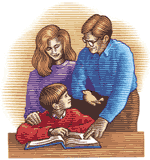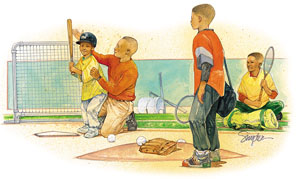![]() May-June 1999
May-June 1999

By Robert W. Peterson
Illustration by Joel Snyder

Young children are not miniature adults, either physiologically or psychologically. That sounds like a truism. But it is often forgotten in organized sports for children. Too often kids are enrolled in competitive sports programs before they are ready, according to Fred C. Engh, founder and president of the National Alliance for Youth Sports (NAYS).
"Children by nature want to play," Engh said, "but that does not necessarily mean they want to play competitive, organized sports. There is a vast difference between play and competition."
In his view, children are ready to decide that they like competitive sports at about the age of 10. By then, he added, kids are prepared for "the things that sports require - discipline and training, working with others, learning how to accept failure and defeat."
For younger children, Fred Engh favors noncompetitive activities like tee ball - a version of baseball in which the young batter hits a ball off a tee and score is not kept. It has the advantage of giving the child practice in baseball skills without putting pressure on him that he is not ready to handle.
Sports for the younger children "should be fun, developmental, motivational, and give the children the chance to learn to love sports," Engh said. "They should not be patterned after professional sports."
NAYS is an alliance of organizations concerned with sports readiness - that time when a child is physically and psychologically ready to participate in organized, competitive sports. It offers a program called Start Smart to introduce kids to sports, teaching them basic skills. A child works one-on-one with a parent to practice such skills as throwing, catching, kicking, and hitting a ball. While the child practices, the parent is being helped to understand that he should not live vicariously through the child and that the child should not be under pressure to win every time.
Children who start playing competitive sports at the age of 5 or 6 can have a high burnout rate, according to Engh. "Seventy percent of the children who started playing sports early will have dropped out by the age of 13," he said. "That's an alarming and disappointing figure, especially if you believe, as we do, that sports have a tremendous value in teaching ethics, fair play, and sportsmanship."
Engh argues in his book Why Johnny Hates Sports (to be released next month by Avery Publishing) that there are three reasons why many youngsters lose interest in sports: First, too many sports programs are run by volunteers who pattern their leagues on professional sports; second, too many coaches aren't trained to deal with children, measuring success by championships; and third, too many parents push their kids to excel.
It should go without saying that a child should want to play a sport before signing up for it. The reality is that a parent who was a baseball star may push his son to join a baseball team when what the boy really wants to do is learn tennis.
Both parent and child should consider the youngster's size and physical maturation when choosing a sport. If he's small for his age, Pop Warner football may not be a good choice. He might try soccer instead.
Another issue is cost. Soccer and basketball don't require much equipment, while ice hockey can be very expensive if the parents have to outfit their child and pay for ice time at a rink. What's worse, because junior hockey teams are low on the priority list for rink time, parents may have to get their youngster to practice at 6 a.m. on school days.
Finally, there are safety considerations in choosing a sport. In their book Elementary Physical Education (Hunter Textbooks, 1992), Robert G. Davis and Larry D. Isaacs offer the following guidelines for ensuring safety in a youth sport:
Offering encouragement means cheering for even easy plays - calling "Good catch!" of an easy pop-up and "Great kick!" for a pass on the soccer field. It's a good idea to say something positive about disappointments - maybe "Nice swing" would do after a strikeout, or "Way to hustle; you'll get 'em next time!" after a team leaves the field after a loss.
There is another reason for parents to attend games. It's to make sure that the coach and other supervisors are not so intent on winning that they jeopardize the players' safety and/or demonstrate poor sportsmanship. The coach should be a "cheerleader" first, an exemplar of fair play and sportsmanship second, and finally, an instructor on skills of the sport. That's a lot to ask of a volunteer, but there are thousands of such people in junior sports programs who more than meet these standards.
But what if your child has the misfortune to get on a team whose coach has a win-at-all-costs attitude? Then you should, at a minimum, have a conference with the coach in a nonconfrontational manner. If that doesn't result in changes in the coach's behavior, you might seriously consider transferring your child to another team.
Remember that coaches - like Scoutmasters and parents - are role models for children.
-Robert W. Peterson is a Scouting magazine contributing editor.
Cub Scout Sports Teach Skills, SportsmanshipThe sports activities in the Cub Scout Sports and Academics program - a supplemental enrichment plan that complements the existing Cub Scout program - can be readily used by parents and Cub Scout and Webelos Scout leaders in introducing young boys to sports. The object of the program is to help boys learn a new skill or improve those they already possess. The Sports portion of the program utilizes topics ranging from bicycling and physical fitness to fishing and skating. The emphasis throughout is on helping a boy develop sports skills and sportsmanship while doing his best and having fun. Participation may take place at home, in a den or pack, or in the community. Adult participation - by a parent or adult relative, if possible - is strongly recommended. Pack leadership determines how the Cub Scout Sports and Academics program is implemented in dens and packs. The Cub Scout Sports and Academics Leader Guide, BSA Supply No. 34296, is the key piece of support literature, explaining the program in depth. - Kathy DaGroomes |
| The Boy Scouts of America | http://www.scouting.org |